Bolton Hall: The Little Landers of Tujunga and the Boom and Bust of a Utopian Garden City

The first thing I noticed when I arrived at Little Landers Park in Tujunga (18 miles north of downtown L.A.) was a rather menacing-looking man. He was sitting on the steps of the pocket park's Bolton Hall Museum, blocking the entrance defiantly. He needn't have bothered with the theatrics -- there was a padlock on the door, and the old stone building had the forlorn look of a place long forgotten. I looked at the clock, and realized I was a few minutes early. The Museum is open on Sundays and Tuesdays from 1-4, and it was only 12:51 pm. I plugged "food" into my GPS and went down the sun-stained streets to get a sub.
When I got back the man had vanished, and a comfortable looking matron was placing a well-worn welcome sign outside the rustic doors. Inside it was dim, and the main room had the feel of my childhood sleep-away camp's mess hall -- high beamed ceilings, solid wood floors, and a giant stone fireplace. The two volunteers kindly gave me a tour and showed me the old display cases that lined the walls. Here was a gavel, an old bag of cement, and a picture of Huell Howser on a long ago visit. In the gift shop there were expensive, regionally printed books for sale. In the back was an old jail cell that now served as storage for yellowing records that documented the history of the area. Before I left, the women were eager that I sign the large guestbook. I did so with flourish, figuring mine might be the only signature of the day.
As I stepped outside, I looked around at the panoramic mess of rundown, urban sprawl that surrounded me. I saw industrial warehouses mixed with hard-lived single family homes and the glare of sweltering cement streets. I thought of the "Little Landers," the idealistic volunteers who had built this hollow building as a clubhouse/meeting hall in 1913. I imagined them standing on this very spot, which was then "the beautiful vale tucked between the Verdugo and Sierra Madre Mountains... 2000-feet above the sea... amidst live oaks... in the mellow mountain climate with a broad and untrammeled outlook over the world." These pioneers had attempted to form a "garden city" -- a tight-knit community of small, co-operative farms which would be self-sustaining and environmentally kind.
The current landscape was evidence enough that their dream had failed.
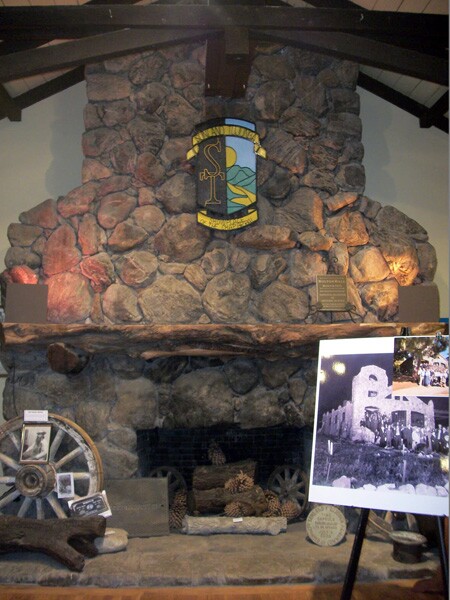

A little land and a living
A little land and a living, surely, is better than a desperate struggle and great wealth, possibly. --W.E. Smythe, 1913 1
Southern Californians, you have made history in the past, and a noble history it is. You have wrested your homes from the clutches of the desert, you have revolutionized the methods of applying water to the soil, you have realized the highest standard of living for average mankind yet known on earth... -- W.E. Smythe, 1902 2

William Ellsworth Smythe was born with the silver spoon that most early Angelenos could only dream of. Born in 1861 in the midst of Civil War, his wealthy Massachusetts upbringing afforded him a chance to go to Harvard. But the idealistic W.E. apprenticed at a newspaper instead, and, inspired by the writings of Horace Greely, he headed west. Affected by the suffering caused by Nebraska's Great Drought of 1890, he used his platform as a progressive reporter at the Omaha Bee to push for widespread irrigation and fair water laws. In 1891 he organized the first National Irrigation Congress in Salt Lake City. In 1893 he chose burgeoning Los Angeles, which he saw as ground zero in the battle for water, as the site of the second convention.
W.E.'s belief in irrigation shaped his whole outlook on society. He was disgusted with the materialism and industrialization of the gilded age, and the increasing corporate privatization of natural resources. Inspired by the writings of back-to-land activist, Bolton Hall, and the common sense agrarian practices of the Mormon community in Utah, he decided to form his own Utopian Colony. W.E. had already fallen in love with the limitless opportunities California afforded, and in 1908 he founded the "Little Landers" cooperative in San Ysidro, only 14 miles from San Diego, on the border with Mexico. Each pioneer family (many from the East) farmed on plots of land from ¼ to 7 acres, living in humble houses and tents. A club house, school house, and a store, for the farmers to sell their wares, were built.
There was much media interest in the story of these picturesque farmers, so anachronistic to the modern age. In 1911, a reporter from the L.A. Times went down to investigate and returned with a story so saccharine it seems just a tad unreal.
Perhaps if you have been dreaming of making your fortune, and of possessing country estates, and city houses and automobiles, and conservatories, and diamonds, and steam yachts and all the other visible and outward signs of the predatory rich, you will not be impressed by a tale of rural simplicity, with each member of the community working more or less unselfishly to promote the general welfare and to secure the blessings of community comforts, independent homes, freedom from wage slavery, healthful surroundings, and plenty of open life, clean air and unobstructed sunshine. For it is a tale of the simple life. Not for the ambitious, but for them who love peace and contentment, is the epic of the Little Lands. When he founded Little Landers, Smythe wished to show people how they could get out on the land, occupying small farms for intensive cultivation, cooperating for light, water and sewer service; perhaps uniting to secure expert advice on the problems of the farm -- how to plant, fertilize, and market the produce of their little farms.3
The initial success of San Ysidro was encouraging to Smythe. In 1913 he teamed with a developer, Marshall Valentine Hartranft, to start a second "Little Landers" on 273 acres in the sparsely developed Tuhunga Valley. The site seemed perfect for a successful commune: open land to cultivate diverse crops, a temperate climate, and a nearby metropolis. But a colony needs a population, and the few families migrating from San Ysidro needed more neighbors to make the co-op viable. So the "Little Landers" established an outpost in downtown L.A. at 929 South Figueroa. Here one could pick up illustrated color pamphlets, talk to settlers, or listen to a lecture by W.E. himself. For only $1, curious Angelenos could go on an auto trip and see plots and view quarter acre lots that could be theirs for as little as $250. If one became a "Little Lander," the $1 was reimbursed. Ads were also taken out in the local papers, like this one:
WOULDN'T you like to be YOUR OWN BOSS, while you are building up a competency for yourself and your loved one? OF COURSE you would and the Little Landers of Los Angeles are showing just how it can be done, how it IS BEING DONE.4
But even in their own laudatory publicity, the "Little Landers" wishful thinking was already creeping into evidence.
We certainly have to pick up the stones in a large portion of the colony tract but the soil is rich and warm, producing quickly and largely without artificial fertilization. The stones are useful for building and other purposes, such as the beautiful clubhouse in which we are assembled amply testifies.5
This clubhouse, "built of everlasting rock," 6 was Bolton Hall Hall. In April of 1913, a cornerstone was laid, with many of the new community in attendance. "Nature builder" and rock mason, George Harris, used granite stones from nearby hills, and claimed the clubhouse design borrowed nothing from traditional "European" design. In an attempt to mimic nature as much as possible, the stones were rolled down hills to see how they naturally landed, and then placed in this position with as little mortar as possible. Harris also carved the fireplace's 14-foot mantle from a single oak tree. Inscribed in the oak is the motto: "To the spiritual life of the soil."
By August, 200 families had purchased land at "Little Landers." They were encouraged by the promise of abundant water and the pitch that a shovel, cement, and the precious everlasting rock was all you needed to build a home. The focal point of this "comfortable if not elegant" commune was to be Bolton Hall (the second "Hall" was usually dropped). In 1914, W.E. explained:
Bolton Hall was built and exists for the service of all our people. It should be available for such meetings and entertainments as all are eligible to attend, but not for secret or limited organizations.7
In time, it would serve as the commune's meeting hall, church, library, movie theater and pot luck space.
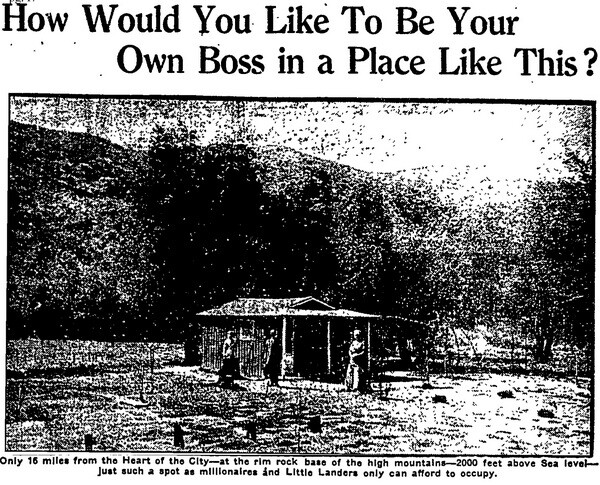
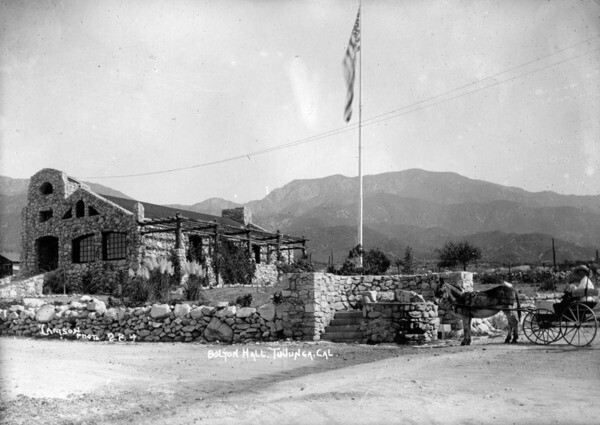

Spinsters and stones
A little land and a living. A paradise retreat. A veritable sanitarium. -- "Little Landers" ad, March 16, 1913 8
The stones were more numerous in some spots than we had supposed. -- W.E. Smythe 9
Who were these hardworking, clean living people who were expected to fill the great hall? Upon researching this article, I must admit I kept thinking, "why live at 'Little Landers' when the most exiting city of the century is only 18 miles away?" Wasn't the "garden city" of Smythe, an Edwardian-age limousine liberal, just another pastoral dream, like Marie Antoinette's "English farm" on the grounds of Versailles, except that middling folks were the guinea pigs instead of pampered courtiers? Were these idealistic people deluding themselves, believing that subsistence farming was really the way to live?
But it seems my knee-jerk cynicism was in many ways incorrect. This isolated commune was indeed a refuge for disenfranchised folks who felt persecuted, out of step, or left behind by the changing times. Among the "Little Landers" were asthma sufferers, Civil War vets, middle aged bachelors, eccentric artists and -- according to settler Mabel Hatch -- "lots and lots of spinsters."10 An amazing article written in June, 1914, describes a dance held by the "Little Landers" at "Hope Hall," which I assume is probably in fact Bolton Hall (though Harris, the anti-European builder, would have been chagrined by the reporter's description):
The white haired folk of Little Landers danced last night till the wee' sma' hours, the steps of colonial days in Hope Hall, where the village prays on Sunday. A hall of stone, constructed along old English lines served to carry out more fully a suggestion of mediaeval times. The glow from a great old fireplace, soft, shaded lights and the great beamed ceiling of oak, produced an effect at once picturesque and withal delightfully charming, and made a fitting setting for the quaint dance. In the weird darkness of the night, the hall appeared in its rugged surroundings a feudal castle where knights and ladies had gathered to pass a merry evening. The figures were called by Mrs. Ensign Woodruff, white-haired and nearly 70, who conducted a dancing class for the college girls and boys in a Wisconsin town half a century ago. The hearts of youngsters who dance the tango and rag could beat with no more enthusiasm that did the hearts of those with silver hair last night, as they danced the figures in "Money Musk", "Pop Goes the Weasel" and the "Oxford Minuet."11
There is a good chance that former domestics, Marie Frish and Anna Souto, were at this hoe-down, dancing together "for lack of male partners." Beloved to many in the community, "the girls" had met when they worked across the street from each other in Santa Barbara. At "Little Landers" they found a place where they could make a life together -- they raised chickens and veggies, and Anna built much admired stone walls. In their downtime, neighbors would join them on crates, eating oranges as they gossiped about others in the settlement.
Indeed, women, who were still fighting for rights as basic as the vote, found a hospitable space in the administrative elite of the "back-to-land movement." Haviland H. Lund was the editor at "Little Farms Magazine," an organizer of the "forward-to-land-league," and a colleague of W.E. Smythe. In a picture of Lund in the May 7, 1913 L.A. Times, she gazes coolly into the camera wearing chic, masculine attire with none of the usual frills and bows of pre-war American women.
The lives of the 500 or so "Little Landers" offered little in the way of frills, and its heyday was brief. Those farming on their small parcels of land quickly found the soil impedingly rocky and difficult to till. Ironically, the promise of abundant access to water never materialized, making irrigation difficult and fires a constant threat. In 1916, a major flood all but wiped out the "Little Landers" settlement at San Ysdrio. A year later, the remaining "Little Landers" of Los Angeles all but dissolved into the crop of new, less idealistic settlers in their Valley. Smythe accepted a commission from the government and moved back east, dying in his posh apartment on New York's Fifth Avenue in 1922, a mess of contradiction to his last.
It wasn't fire that put the nail in the coffin of the "Little Landers", but cold, hard capitalism. Some of the original settlers stayed in Tujunga, including Marie and Anna. Many more sold off their small plots of land in the real estate boom of the 1920s. Bolton Hall became the American Legion, then the first city hall for the incorporated town of Tujunga (a Native American word meaning "Village of the Old Woman"). When Tujunga was annexed into L.A. in 1932, Bolton Hall continued to be the area's municipal building, complete with a small jail that the city bought second-hand from Glendale. When a bigger municipal building was built in 1957, the old stone Hall was "tightly sealed," and vandals quickly went to work, knocking out most of the windows.
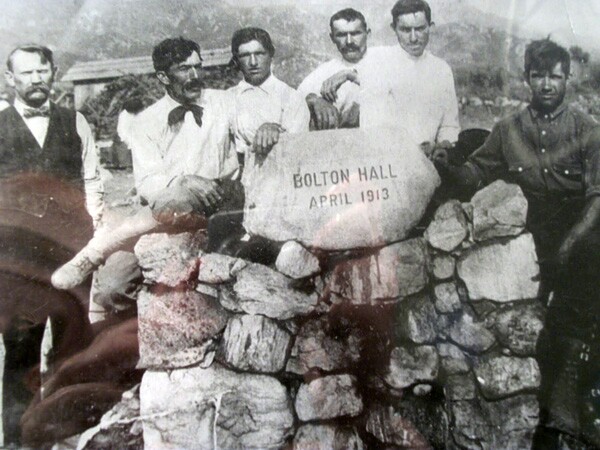

An "Obsolete" building
If we lose Bolton Hall, we lose the heart and pulse of the community. The hall is more than a building. It is Tujunga itself. -- Mrs. Estelle Prins, 1964 12
It's shameful that a tiny minority can hold up such a project. The park is needed. What are you waiting for? -- Councilman Louis Nowell, 1964 13
The fight to save Bolton Hall spanned almost as many years as its civic relevance. After two failed attempts to auction off the building, the city made plans to tear it down. A group of longtime Tujunga citizens, a majority of respected women, were appalled. In 1959 they formed the Little Landers Society and began a vigorous campaign to save the building, which was in need of extensive renovations. Over the next two decades, a battle waged between the historical society and many on the city council and the Recreation and Parks Department, who deemed the building "obsolete." 14
After many contentious and heated public meetings, in 1966, a temporary truce was reached. The Little Lander Park, featuring a children's play structure, was opened on the grounds of the still abandoned Bolton Hall. A year later, the Hall received a historic plaque as the fight over its ultimate fate continued. Petitions were circulated, appeals filed and money raised to save the building, which by the late '60s had fallen prey to graffiti. In 1976 plans were announced to turn the Hall into a heritage museum and library. Decades-growth of ivy was stripped from the building in preparation for renovation.
It was not until 1980, after a collection of public and private funds were secured, that the Hall was finally reopened as a Museum. In the form of the historic society the "Little Landers" again had control of Bolton Hall, and set about attempting to teach the working class city people of Tujunga about their idealistic, agrarian beginnings. But do they care? Is the show over? One of the original artifacts the museum displayed was a letter of encouragement to the builders from Bolton Hall himself. According to a former president of the historical society: "Although Bolton Hall was pleased with plans for the building, we have no evidence he ever visited here."
There is perhaps no better epitaph for this Hall made of native rock, the "heart and pulse" of a ideology which didn't quite make it to the mountaintop.


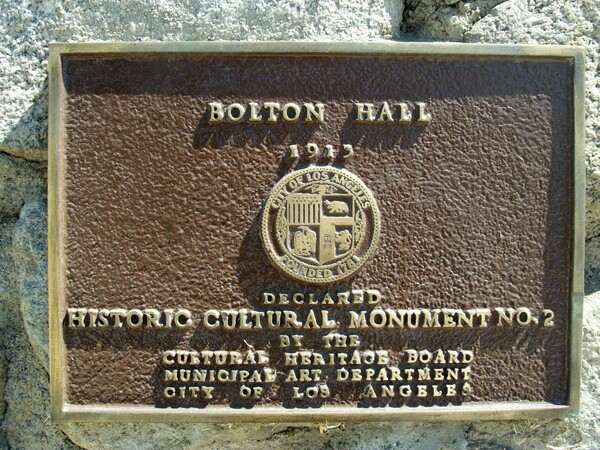
Additional Photos By: Hadley Meares
_____
1 "Instead of Utopia, It Left a Lot of Lots to Be Desired" Los Angeles Times, January 8, 1996
2 "Great Fight on Irrigation" Los Angeles Times, December 30, 1902
3 "The Little Landers: A Sociological Experiment in the Southwester Corner of the United States" Los Angeles Times, January 8, 1911
4"How Would You Like to be Your Own Boss in a Place Like This?" Los Angeles Times, July 13, 1913
5 "The Little Landers Speak for Themselves" display ad, Los Angeles Times, October 12, 1913
6 "The Life of the Little Landers" display ad, Los Angeles Times, September 21, 1913
7 "Historic Bolton Hall Promised New Life as Community Center" Los Angeles Times, November 18, 1979
8 "Little Landers Plans Announced" Los Angeles Times, March 16, 1913
9 "Instead of Utopia, It Left a Lot of Lots to Be Desired" Los Angeles Times, January 8, 1996
10 "Valley Life; Tujunga's Pioneer Women Lived on the Rocks" Los Angeles Times, April 9, 1999
11 "Little Landers Dancing Jigs" Los Angeles Times, June 21, 1914
12 "Save Bolton Hall Drive Sponsors Near Deadline to Raise Funds" Los Angeles Times, March 8, 1964
13 "Fate of Bolton Hall to be Debated Again" Los Angeles Times, July 19, 1964
14 "Citizens Open Drive to Save Bolton Hall"Los Angeles Times, April6, 1963